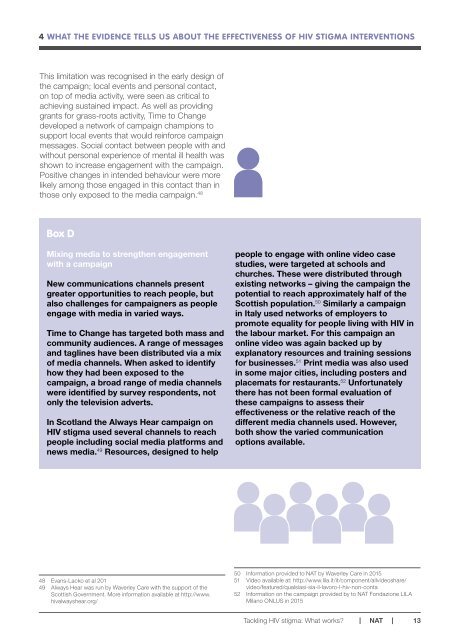Tackling HIV Stigma What works?
Jun_16_Tackling_HIV_Stigma
Jun_16_Tackling_HIV_Stigma
You also want an ePaper? Increase the reach of your titles
YUMPU automatically turns print PDFs into web optimized ePapers that Google loves.
4 WHAT THE EVIDENCE TELLS US ABOUT THE EFFECTIVENESS OF <strong>HIV</strong> STIGMA INTERVENTIONS<br />
This limitation was recognised in the early design of<br />
the campaign; local events and personal contact,<br />
on top of media activity, were seen as critical to<br />
achieving sustained impact. As well as providing<br />
grants for grass-roots activity, Time to Change<br />
developed a network of campaign champions to<br />
support local events that would reinforce campaign<br />
messages. Social contact between people with and<br />
without personal experience of mental ill health was<br />
shown to increase engagement with the campaign.<br />
Positive changes in intended behaviour were more<br />
likely among those engaged in this contact than in<br />
those only exposed to the media campaign. 48<br />
Box D<br />
Mixing media to strengthen engagement<br />
with a campaign<br />
New communications channels present<br />
greater opportunities to reach people, but<br />
also challenges for campaigners as people<br />
engage with media in varied ways.<br />
Time to Change has targeted both mass and<br />
community audiences. A range of messages<br />
and taglines have been distributed via a mix<br />
of media channels. When asked to identify<br />
how they had been exposed to the<br />
campaign, a broad range of media channels<br />
were identified by survey respondents, not<br />
only the television adverts.<br />
In Scotland the Always Hear campaign on<br />
<strong>HIV</strong> stigma used several channels to reach<br />
people including social media platforms and<br />
news media. 49 Resources, designed to help<br />
people to engage with online video case<br />
studies, were targeted at schools and<br />
churches. These were distributed through<br />
existing net<strong>works</strong> – giving the campaign the<br />
potential to reach approximately half of the<br />
Scottish population. 50 Similarly a campaign<br />
in Italy used net<strong>works</strong> of employers to<br />
promote equality for people living with <strong>HIV</strong> in<br />
the labour market. For this campaign an<br />
online video was again backed up by<br />
explanatory resources and training sessions<br />
for businesses. 51 Print media was also used<br />
in some major cities, including posters and<br />
placemats for restaurants. 52 Unfortunately<br />
there has not been formal evaluation of<br />
these campaigns to assess their<br />
effectiveness or the relative reach of the<br />
different media channels used. However,<br />
both show the varied communication<br />
options available.<br />
48 Evans-Lacko et al 201<br />
49 Always Hear was run by Waverley Care with the support of the<br />
Scottish Government. More information available at http://www.<br />
hivalwayshear.org/<br />
50 Information provided to NAT by Waverley Care in 2015<br />
51 Video available at: http://www.lila.it/it/component/allvideoshare/<br />
video/featured/qualsiasi-sia-il-lavoro-l-hiv-non-conta<br />
52 Information on the campaign provided by to NAT Fondazione LILA<br />
Milano ONLUS in 2015<br />
<strong>Tackling</strong> <strong>HIV</strong> stigma: <strong>What</strong> <strong>works</strong>? NAT 13


